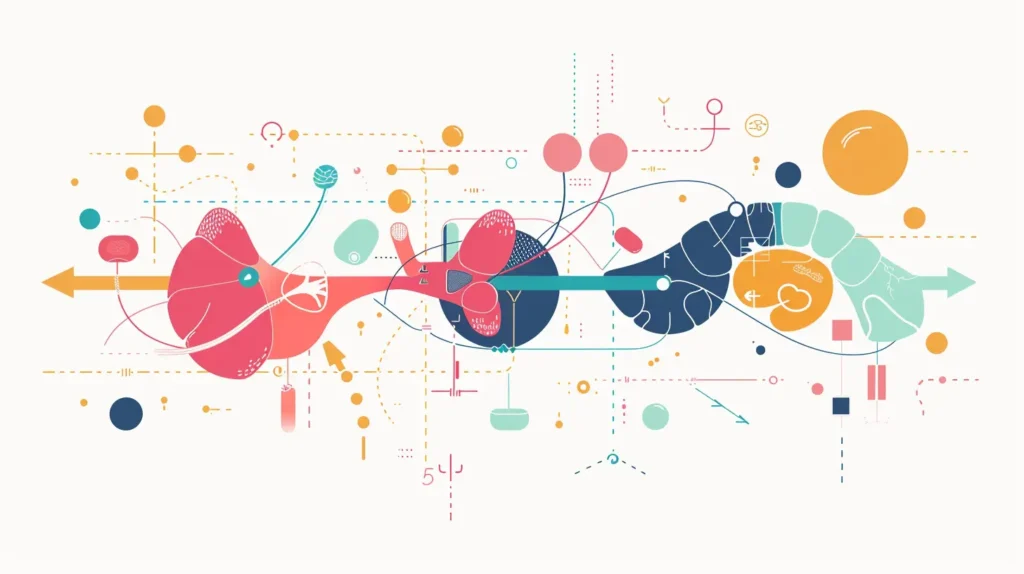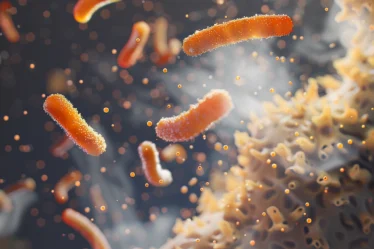
When you run or skip a meal, your body quickly releases a hormone that stops your blood sugar from dropping too low. This hormone, glucagon, tells the liver to break down stored glycogen and release glucose, keeping your muscles active and your brain alert even without new food.
In this study guide, you will read how glucagon controls blood sugar and energy. We explain how the pancreas produces glucagon, what triggers its release, and how it affects sugar, fat, and protein metabolism. You will also learn how glucagon changes in diabetes and during fasting or exercise.
Glucagon: Quick Summary
Do you just need the basics? Here’s a simple explanation of what glucagon does:
🟠 Glucagon is a hormone released by the pancreas that raises blood sugar by signaling the liver to break down glycogen and produce glucose.
🟠 Low blood sugar, exercise, and certain amino acids trigger glucagon secretion, while insulin and somatostatin block it.
🟠 Glucagon metabolism activates glycogenolysis, gluconeogenesis, lipolysis, and ketogenesis to keep your body fueled during fasting or stress.
🟠 In diabetes and obesity, glucagon levels rise abnormally, causing the liver to release extra glucose and worsening blood sugar control.
🟠 Glucagon reduces appetite, increases energy use, and triggers the urea cycle to remove toxic ammonia during protein breakdown.
What Is Glucagon and How Does It Affect Blood Sugar?
Glucagon is a hormone that keeps your blood sugar from dropping too low. Your pancreas releases it when glucose levels fall. Alpha cells inside the pancreas detect the change and react fast. Glucagon signals the liver to break down stored glycogen into glucose. This process sends more sugar into your blood, giving your muscles and brain the fuel they need.
You need this hormone most during fasting, exercise, or long breaks between meals. While insulin lowers blood sugar, glucagon works in the opposite way. Both hormones keep your glucose levels balanced.
Glucagon release starts when certain conditions signal your body needs more energy. These triggers activate alpha cells to release glucagon:
- Low blood sugar (hypoglycemia)
- Physical activity or stress
- High levels of amino acids such as alanine
- Hormones like epinephrine and cholecystokinin
These signals ensure your body keeps blood sugar steady when food isn’t available.
How the Body Produces and Processes Glucagon
Glucagon is a small peptide hormone made of 29 amino acids. Its sequence gives it the shape needed to fit into receptors and trigger glucose release. The pancreas produces glucagon by cutting a larger molecule called proglucagon.
Inside the alpha cells, an enzyme named prohormone convertase 2 (PC2) processes proglucagon. This reaction produces active glucagon, ready to move into the bloodstream when your body needs more glucose. Proglucagon, however, doesn’t always produce glucagon. In other organs, it takes a different path.
Find Out Where Glucagon Is Made in the Body
The pancreas produces the active form that raises blood sugar. Your intestines and brain also process proglucagon, but they produce other hormones instead.
| Location | Processing Enzyme | Main Products |
| Pancreas | PC2 | Glucagon |
| Intestine | PC1/3 | GLP-1, GLP-2, oxyntomodulin, glicentin |
| Brain | PC1/3 | GLP-1, GLP-2 |
This process allows one gene to create different hormones depending on where it happens. Only glucagon from the pancreas raises blood sugar during fasting, exercise, or stress.
Regulation of Glucagon Secretion
Your pancreas releases glucagon when blood sugar drops. Alpha cells sense this change and react fast. Glucagon signals the liver to release glucose, keeping your blood sugar steady. When glucose rises, glucagon release slows down or stops.
Several triggers tell alpha cells to release glucagon. Others block it to prevent too much sugar in the blood.
Secretion triggers:
- Low blood sugar (hypoglycemia)
- Physical activity or stress
- High levels of amino acids like alanine
- Hormones such as epinephrine and cholecystokinin
Secretion inhibitors:
- High blood sugar (hyperglycemia)
- Insulin
- Somatostatin
- Amylin
Alpha Cells Release Glucagon
Alpha cells act like tiny sensors. When glucose drops, less ATP forms inside the cells. This change closes potassium (K⁺) channels and shifts the membrane’s electrical charge. The cell depolarizes, and calcium (Ca²⁺) channels open. Calcium flows in and triggers glucagon release. Once glucose rises, potassium channels reopen, stopping the release.
Glucagon Controls Sugar, Fat, and Protein Metabolism
Glucagon keeps your blood sugar stable when food is low. It signals the liver to break down glycogen into glucose. This process, called glycogenolysis, quickly raises blood sugar. When glycogen runs out, the liver makes new glucose from amino acids and other molecules. This process is gluconeogenesis.
Glucagon also helps your body switch to burning fat. It activates lipolysis, breaking stored fat into fatty acids. The liver uses these fatty acids for energy or converts them into ketone bodies. This process, called ketogenesis, gives your brain and muscles another energy source during fasting or exercise.
How Glucagon Affects Protein Breakdown
When fat and sugar run low, glucagon signals the liver to break down amino acids. Some turn into glucose. Others release ammonia, which is toxic. Glucagon activates the urea cycle. This cycle changes ammonia into urea so your kidneys can remove it from the body.
Glucagon’s metabolic actions:
- Triggers glycogen breakdown (glycogenolysis)
- Starts new glucose production (gluconeogenesis)
- Breaks down fat (lipolysis)
- Produces ketone bodies (ketogenesis)
- Supports protein breakdown and the urea cycle
These actions keep your body supplied with energy, especially during fasting, exercise, or when glucose is low. Glucagon makes sure your brain and muscles keep working.
Glucagon Activates Receptors and Signals Cells
Glucagon works by attaching to receptors on liver cells. These receptors belong to a group called G protein-coupled receptors. Once glucagon binds, the receptor changes shape and activates a G protein inside the cell. This signal starts a chain of reactions that pushes the liver to release glucose.
The liver responds the most because it stores glycogen. Other organs like the kidneys or heart react less since they have fewer receptors.
The cAMP and PKA Activation Cascade
The G protein activates an enzyme called adenylyl cyclase. This enzyme turns ATP into cyclic AMP (cAMP), which acts as a messenger inside the cell. cAMP quickly activates protein kinase A (PKA).
PKA switches on glycogen phosphorylase, the enzyme that breaks glycogen into glucose-1-phosphate. At the same time, PKA turns off glycogen synthase to stop the liver from storing new glycogen. These changes push the liver to release stored glucose into the blood.
This signaling pathway works fast and keeps your blood sugar steady when you need extra energy. It supports your body during fasting, exercise, or stress by making sure enough glucose stays available for your brain and muscles.
How Glucagon Affects Appetite and Energy Use
Glucagon does more than control blood sugar. It also affects how your body uses energy and controls hunger. After glucagon release, your body starts burning stored fat. This switch increases energy use, especially during fasting, exercise, or cold exposure. Some studies show that glucagon raises resting energy expenditure, helping the body create energy from fat stores.
Glucagon can also reduce hunger. When levels rise, you feel less need to eat. Scientists think this happens because glucagon signals the brain or changes metabolism in the liver. However, this appetite-reducing effect is mostly seen when glucagon levels rise quickly, such as during an injection.
Some studies suggest glucagon may affect the heart. High doses can raise heart rate and improve heart contractility. Doctors sometimes use glucagon in emergencies like beta-blocker overdose. Still, in normal conditions, glucagon does not change heart rate or directly affect how the heart works.
How Glucagon Changes in Diabetes and Obesity
Glucagon secretion changes in diabetes and obesity. These changes keep blood sugar high and make it harder for your body to manage energy. Normally, insulin controls how much glucagon your pancreas releases. In diabetes, this control breaks down.
Glucagon in Type 1 Diabetes – Post-meal Spikes
In type 1 diabetes, your pancreas stops making insulin. Without insulin, alpha cells release too much glucagon after meals. The liver keeps breaking down glycogen and adding glucose to the blood, even when food already raised sugar levels. This reaction makes blood sugar spike after eating.
Glucagon in Type 2 Diabetes – Fasting Elevation
In type 2 diabetes, insulin works poorly. Alpha cells keep releasing glucagon, even during fasting. The liver reacts by producing more glucose, raising blood sugar even before you eat.
Obesity and fatty liver disease cause similar problems. The liver struggles to process amino acids. This triggers a signal that pushes alpha cells to release more glucagon. Scientists call this the liver-alpha cell axis. It keeps glucagon levels high and increases fat buildup in the liver.
These changes explain why diabetes and obesity often raise blood sugar. The liver keeps producing glucose, even when the body doesn’t need it. This extra glucose makes managing blood sugar much harder.
Key Moments in Glucagon Discovery
Scientists first noticed glucagon in the 1920s while studying pancreatic extracts. They saw that blood sugar rose before insulin took effect. In 1923, researchers named the hormone glucagon, short for “glucose agonist.”
By the 1950s, scientists isolated pure glucagon and mapped its amino acid sequence. This made it possible to use glucagon as a treatment for severe low blood sugar. In 1959, the development of a radioimmunoassay allowed researchers to measure glucagon levels accurately.
Later, gene studies revealed that proglucagon produces several hormones. Processing depends on where it happens—mainly the pancreas or intestines—giving glucagon multiple functions in the body.
Get Help with Glucagon and Metabolism Topics
Struggling with glucagon, metabolism, or hormone pathways? You’re not the only one—these topics can get confusing fast. A private biochemistry tutor for high school helps you sort it out step by step, so you don’t get lost in all the reactions and processes.
During tutoring biochemistry lessons, you’ll break down how glucagon triggers glycogen breakdown or why the liver starts making glucose when you’re hungry. Your tutor explains it clearly and shows you how to connect the theory with real exam questions—because memorizing isn’t enough.
If you’re searching for local help, try “biochemistry tutor Birmingham” or “tutoring biochemistry Sheffield”. You’ll also find good options like “organic chemistry tutoring Leicester” for help with biochemical reactions.
One huge benefit? You practice the types of questions that show up on tests, especially around glucagon’s effect on fat and protein metabolism. That kind of focused practice builds skills fast.
Don’t wait until you fall behind. Book a biology, chemistry or biochemistry tutoring session on meet’n’learn and work through metabolism together—at your pace, with someone who knows how to explain it.
Looking for more resources? Check out our Biology blogs for additional learning material. If you’re ready for extra help, a tutor can guide you through the most challenging topics with clarity and patience.
Glucagon: Frequently Asked Questions
1. What is glucagon?
Glucagon is a hormone released by the pancreas that raises blood sugar by signaling the liver to release glucose.
2. When does the body release glucagon?
The body releases glucagon during low blood sugar, exercise, fasting, and stress.
3. How does glucagon increase blood sugar levels?
Glucagon triggers glycogenolysis and gluconeogenesis in the liver, sending more glucose into the bloodstream.
4. What triggers glucagon secretion?
Low blood sugar, amino acids like alanine, physical activity, and hormones such as epinephrine trigger glucagon secretion.
5. How does glucagon affect fat metabolism?
Glucagon activates lipolysis, breaking down fat stores to produce energy and ketone bodies.
6. What happens to glucagon levels in type 1 diabetes?
Glucagon levels spike after meals in type 1 diabetes because insulin is missing and can’t stop glucagon release.
7. How does glucagon relate to the liver-alpha cell axis?
In obesity and fatty liver, poor amino acid processing by the liver increases glucagon secretion through the liver-alpha cell axis.
8. Can glucagon affect appetite and energy use?
Yes, glucagon reduces hunger and increases energy use by promoting fat breakdown and raising resting energy expenditure.
Sources:



